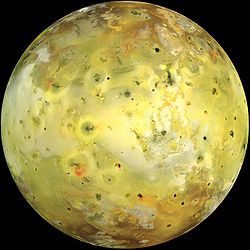Io
 This Fenspace article is a stub. You can help FenWiki by expanding it.
This Fenspace article is a stub. You can help FenWiki by expanding it.
| Io | |
 | |
| Planetary characteristics | |
|---|---|
| Orbit | 421,700 km from Jupiter (mean) |
| Diameter | 3,630.6 km (equatorial) |
| Surface Gravity | 0.18 G |
| Year | 42.5 hours |
| Day | 42.5 hours |
| Mean Temperature | 110°K (-163.15°C) mean |
| Atmosphere | trace (90% SO2) |
| Water/Ice Index | 0% |
| Population (2013) | varies (tiny) |
| Political Affiliation | Fenspace Convention |
| Government | n/a |
| Capital | n/a |
Io is the inner most of the Galilean moons of Jupiter. A relatively large[1] satellite, it is the most volcanically active body in the solar system. Tidal stresses introduced during Io's orbit of Jupiter heat the interior of the moon to great levels. Plumes of molten sulphur compounds and silicates can be launched 200km from the moon's surface during some volcanic events and lakes of molten sulfur compounds can be found across the surface.
The moon's surface is mostly yellow and white because of the sulfur. Except near the poles where radiation damage turns the sulfur red.
Io is largely uninhabited, and is considered massively unsuited to colonization for several reasons. The main two of these being the strength of the Jovian magnetic field around Io[2] and the moon's vulcanism. The Whedonites and Heinleinians occasionally send short term prospecting and mining operations to Io. There's a lot of sulfur and magnesium to be harvested. But it is far too dangerous to attempt a permenant settlement.
Known Places on Io
- none
Related Links
Related Websites
These are sources of hard-science information and inspirational imagery for anyone who wants to write about the Jovian subsystem in Fenspace. So far, all sites are on NASA servers. Ideally, these links should be incorporated into the articles that should be written for this page, then this section deleted after the articles are posted here.
- Solar System Exploration: Planets: Jupiter
- Milennium Flyby
- The Galileo Project
- Io's Surface: Under Construction - the Astronomy Picture of the Day for 2008 August 17
Notes
- ↑ About 5% larger in diameter and 20% more massive than Luna.
- ↑ There is a belt of radiation centered on Io, and the moon receives approximately 3,600 rem a day.